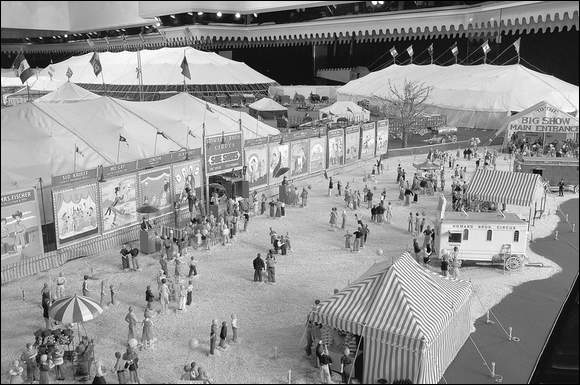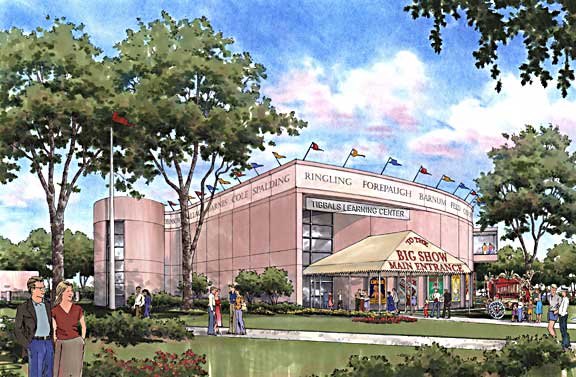Tibbals' lifework is a tribute to all
things circus
By CHARLIE HUISKING, HeraldTribune. January 8, 2006
charlie.huisking@heraldtribune.com
Like many American kids in the 1940s, Howard Tibbals was thrilled the first time he saw
the circus come to town. But the daring tightrope walkers and the roaring lions and tigers
weren't the main attractions for Tibbals that summer in West Virginia. Peering through
binoculars from a neighbor's hillside front porch, he was mesmerized as he watched
roustabouts pound the stakes of the big top, unfurl thousands of yards of canvas and
unload hundreds of red wagons. "I was struck by what a massive operation the circus
was, the 69-year-old Tibbals said. "I was fascinated by the mechanics of it, by how
they'd travel to a new town each day and set up a virtual city. It left quite an
impression."
Visitors to the Ringling Museum of Art's new Tibbals Learning Center will get a sense of
what Tibbals was feeling that day. About to go on permanent display in the center's first
floor is the sprawling, handcrafted miniature circus that has been Tibbals' passion since
he began work on it 50 years ago.

Built on a 3/4-inch-to-1-foot scale, it is the largest model circus in the
world, occupying 3,800 square feet.
It encompasses eight main circus tents, including a big top with 7,000 tiny folding chairs
and three rings and four stages full of clowns, aerialists and showgirls. Lined up in an
adjacent rail yard are 55 railroad cars and 152 circus wagons. Each bears the
hand-lettered name of the Howard Bros. Circus. The model, which also has dining and
dressing tents, a sideshow, a menagerie and a cookhouse, is actually a carefully
researched replica of the Ringling Bros. and Barnum & Bailey Circus, during its
tent-show heyday in the 1930s.
Tibbals began working on the project in 1956, when he was studying engineering at North
Carolina State University. But when he wrote Ringling circus officials for permission to
use their name and logo on his models, they declined. "They actually saved me a lot
of trouble," Tibbals said, laughing. "I didn't have to put that long, 'Ringling
Bros. and Barnum & Bailey' name on everything." Portions of Tibbals' circus have
been exhibited at the 1982 World's Fair in Knoxville, Tenn., at the National Geographic's
Explorer's Hall in Washington, D.C., and at the Circus World Museum in Baraboo, Wis.
The retired owner of a Tennessee wood flooring company who winters in Sarasota, Tibbals
gave his collection to the Ringling Museum of Art in 1999. At the same time, he he donated
$3 million for a building to house it, and another $3.5 million for an endowment. The
museum, which is operated by Florida State University, obtained additional donations and
matching state funds for the $16 million project. Opening to the public on Saturday, the
30,600-square-foot building also will showcase some of the 5,700 vintage circus posters
and 1 million circus photographs in Tibbals' collection.
Another model exhibit -- this one of a 150-foot-long circus parade -- will be displayed in
the building's second floor. Acquired by Tibbals, it was crafted by Harold Dunn, his
modeling mentor. The center's second floor also is devoted to a history of the circus,
from Roman times to Cirque du Soleil. The colorful exhibits cover everything from P.T.
Barnum and Buffalo Bill to Sarasota's circus heritage. "The focus has rightly been on
Howard Tibbals' circus, but I think people are also going to be astounded by the
historical exhibits on the second floor," said Debbie Walk, curator of the museum's
circus collections. (The Ringling's existing circus museum, which contains wagons, photos
and other artifacts, will continue to operate.) Guests will approach the Tibbals Learning
Center through the ticket office in the museum's new Visitors Pavilion, which also opens
this week.
Before entering the contemporary-style Tibbals building, they'll pass through a tent with
circus-red letters proclaiming, "To the Big Show, Main Entrance." "The tent
is an exact replica of the Ringling show's main-entrance tent in the 1930s," Tibbals
said. "The architect for this building came up with the idea for a tent. But I had
the exact dimensions. I have all that stuff."

Indeed, Tibbals has spent the past 50 years researching every aspect of
circus life, so that his scale-model could be as accurate as possible. "Howard's mind
is incredible -- the things he can remember," Walk said. "I could only hope to
attain the knowledge of the circus that he has. It's in his bones. "And he has such
amazing creativity and determination. Nothing is daunting to him."
Tibbals was involved in every aspect of the building's design and construction. And he
spent the last 14 months installing his exhibit, piece by tiny piece. It took him almost
six months to lay 900 feet of miniature rail lines, complete with 7,500 wooden cross-ties.
"The level of authenticity is amazing, and it extends to things p ople will never
see," said Larry Kellogg, a former Ringling circus publicist who is working on the
project. "The three ticket wagons have tiny typewriters and adding machines inside
them, for example."
Tibbals' wife, Janice, helped with some aspects of the installation. Using a pair of
tweezers, she put miniature tablecloths and hundreds of tiny knives, forks and glasses on
the tables in the dining tent. She outfitted the dressing tent with minuscule bars of soap
and tubes of lipstick, and scattered sawdust on the exhibit's floor. "All I did was
help put the picture frame around the picture that Howard created," she said.
"I'm so pleased for him, because this circus been his life's work. It wasn't his job,
but it was his life's work. He was as focused on this project as a racehorse with blinders
on. And the (Tibbals Center) has turned out even better than either of us could have
dreamed of." Tibbals is a good-natured, unassuming man who would rather wear a
comfortable old coat than a suit or a tuxedo. "Howard is solid and stable, and not at
all interested in impressing the world," his wife said. "He's not impressed with
himself -- or with anybody else." Tibbals' philanthropy didn't begin with his
Ringling donations. He contributed millions to support public-school construction in
Oneida, Tenn., the small town where he and his wife spend much of the year.
Tibbals, who has nine children and 15 grandchildren, is particularly pleased that his
circus collection is being housed in a building called a learning center. "I believe
strongly in education, and that's why I'm pleased that FSU has played such a role in
making this happen," he said. "Visitors here will be able to learn so much, not
only about the circus, but about the railroads in America, about small-town life, and
about how entertainment and advertising evolved."
During a recent tour of his circus, Tibbals pointed out things the casual visitor might
miss, including a sign for the Tibbals Flooring Co. in the 1930s skyline of Knoxville
that's part of the exhibit. "All the other signs, White Lily Flour, for instance,
were actual businesses in Knoxville," he said, smiling. "My business was
actually 70 miles away. But we made an exception." Tibbals is feeling a mixture of
accomplishment and relief as opening day approaches. "We'll be delighted to get back
to normal, and spend more time with the family members," he said. "We've been
kind o f divorced from them in the past couple of years while focusing on this." But
he doesn't plan to walk away once the ribbon is cut on Saturday. A workshop has been
reserved for him on the second floor, where visitors can watch him create new pieces.
"This model isn't totally built yet," he said. "I'm a little light in
railroad equipment, for instance. There's still a lot I want to add."
ringlingdocents.org
|

